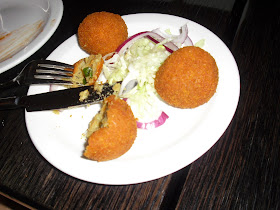The era also spawned some bands that fell between these two extremes. Bands like Shed Seven and The Bluetones, who knocked out some killer tunes but whose albums could be patchy. In my opinion, songs like Chasing Rainbows and Slight Return would make anyone's Britpop compilation tape (tape – that's how old I am).
I know what you're thinking, just what the hell has this got to do with Sri Lankan food ? Well, part way through my meal at Papaya, I decided that this Ealing restaurant was a bit like Shed Seven. Having suggested The Bluetones, Mr Pak Choi then decided they were bit too good to be represented by Papaya in my 'ranking by Britpop' system. Apologies if you're bemused but please bear with me !
As Papaya is my mate Nuf's local, the family Nuf consisting of Mrs Nuf, Fay, and Yasmin joined us. Also in attendance were Mr Pak Choi, El Greco, and Mysterious Miss A (I promised everyone a mention in the style of radio DJ's of old).
First impressions were positive as the warm interior made us feel at home from the off. Although it was quite empty when we rolled up at 7.30, the dining room soon filled with groups of mates, couples, and family outings, which gave it a convivial atmosphere.
First impressions were positive as the warm interior made us feel at home from the off. Although it was quite empty when we rolled up at 7.30, the dining room soon filled with groups of mates, couples, and family outings, which gave it a convivial atmosphere.
Being a group of eight meant we could give the mainly Sri Lankan and South Indian menu a good going over. Although there were a few High Street curry house dishes for numpties the unadventurous, I gently encouraged my fellow diners to go Sri Lankan or at least South Indian and with one or two exceptions, they complied.
The starters were cheap with none costing more than £3.50 but when the poppadoms were the highlight, you know you've got a problem. I can't be certain but many of the starters had a "made somewhere else" feel about them with only the uridu vadai (dhal rings) looking anything like own-made.
I wasn't a fan of the doughnut-like uridu vadai, and whilst the accompanying chutney was tasty, they were bland and stodgy – not at all dhal-y. I didn't try the samosas or the crab claws although the latter looked like the Chinese restaurant two doors down could've served it. Not the most promising of starts.
I had full-on main course envy when I tried the kothu. Just why the hell didn't I order this ? A choice of rotti, string hoppers, or pittu chopped up and mixed on a griddle with egg, onions, chilli, with either seafood, meat or veg.
Having let the side down with his safe choice of meat samosa starter, El Greco plumped for chicken masala dosai. I didn't get to try it as he soon polished it off which meant that it was either really tasty or he was really nervous having seen me have a crack at everybody else's main.
We also ordered loads of sides including okra curry, coconut sambol, chapathi, paratha, poori, egg rotti, lemon rice, and string hoppers (I think I may have missed out a few). Sadly some of these sides stopped the mains from going for gold. In particular, the family Nuf thought the chapathi was thick and doughy whilst PC likened the texture of the poori to the outside of a microwaved petrol station pasty. Well at least they didn't balls up the string hoppers as there is no way back from noodle failure.
The bill was roughly £250 between eight including service. This was excellent value when you consider: 1) we were there for over three hours during which time we were amply topped up with Sri Lankan Lion lager, wine, lassis, and whisky (Nuf's latest fad) and 2) we over ordered as the masala dosai and kothu were complete meals and we didn't need that many side dishes.
Service was good although the waiters did initially try to take the piss by getting us to order even more side dishes. Overall, it was a great night out and we all left keen to sample more Sri Lankan food.
Verdict: Shed Seven were a great live act with some killer singles and to draw parallels, Papaya is a good night out with some excellent dishes. Yet like the York band, there are problems with consistency, in particular the disappointing starters and sides. In short, this is a decent neighbourhood restaurant but not somewhere you'd go out of your way to visit.
Other Stuff: Although Papaya is in Ealing with a branch in Rayners Lane, most of London's Sri Lankan eateries can be found in Tooting and Wembley.

























